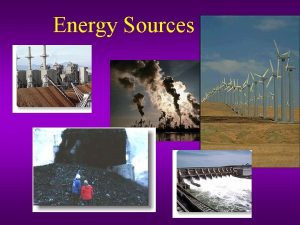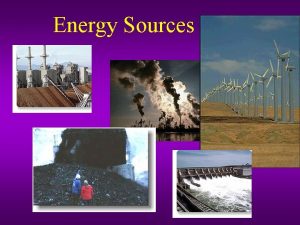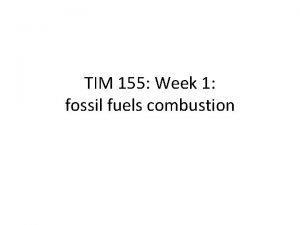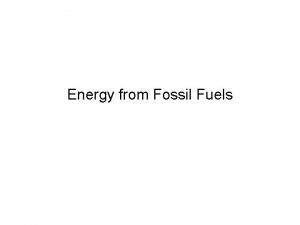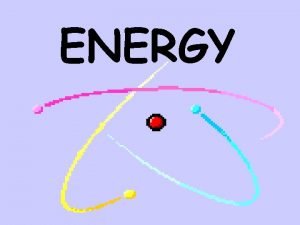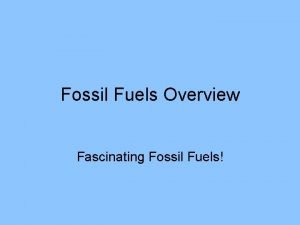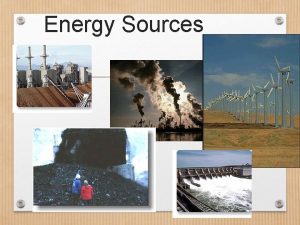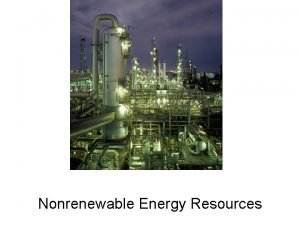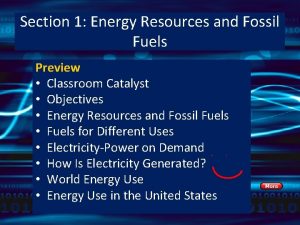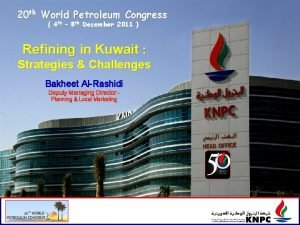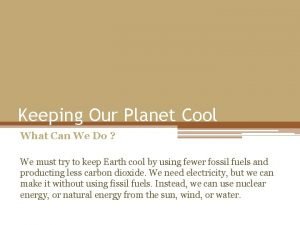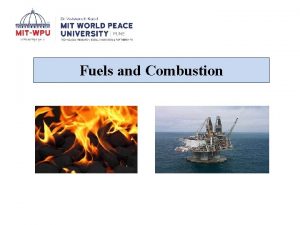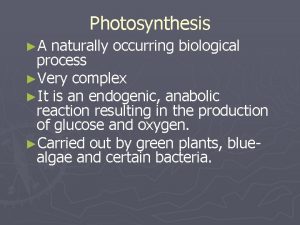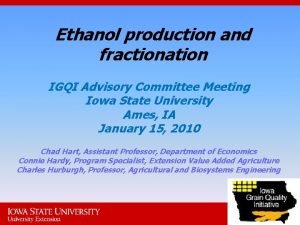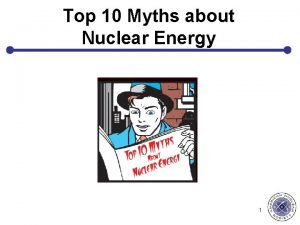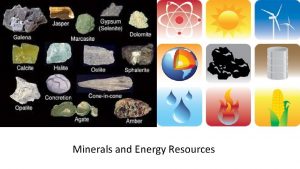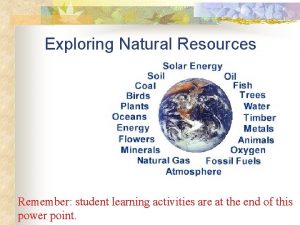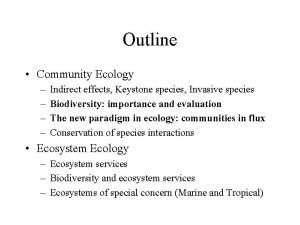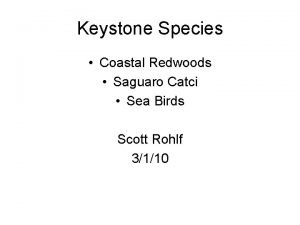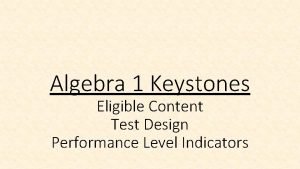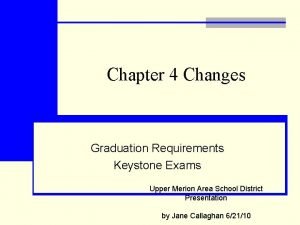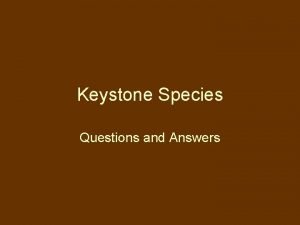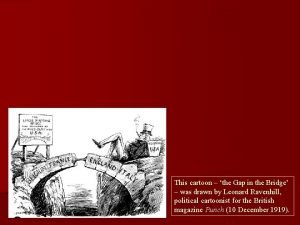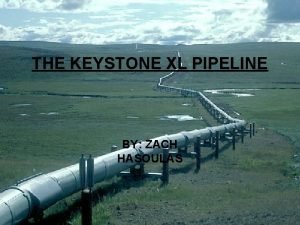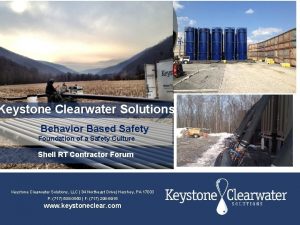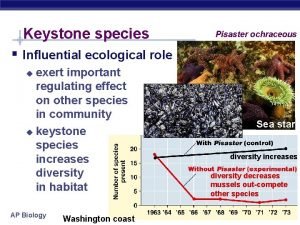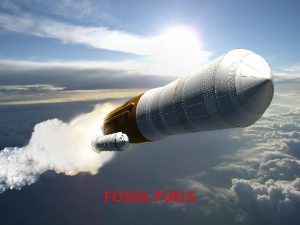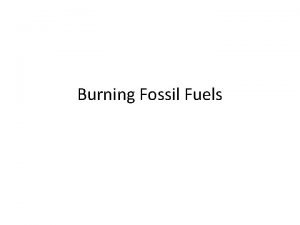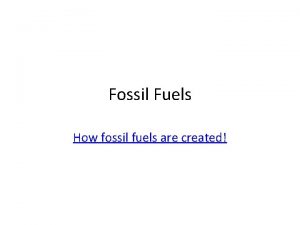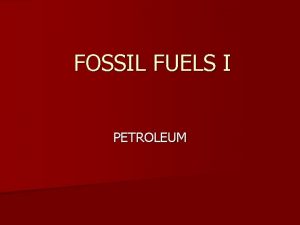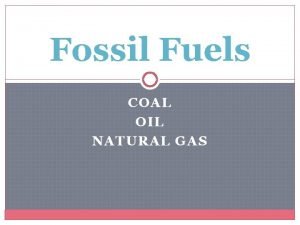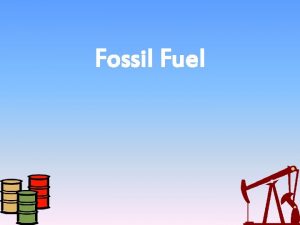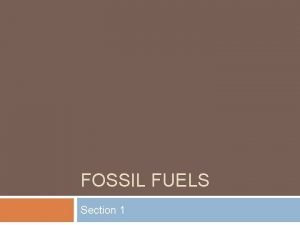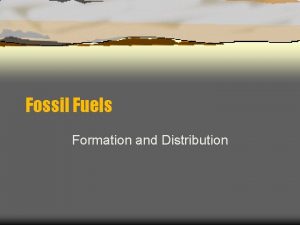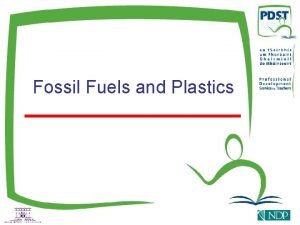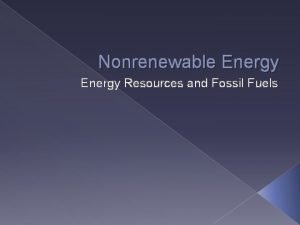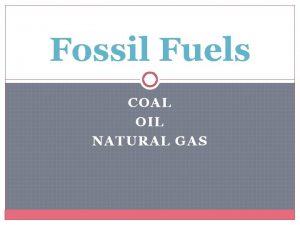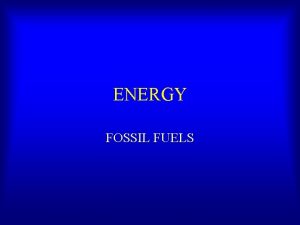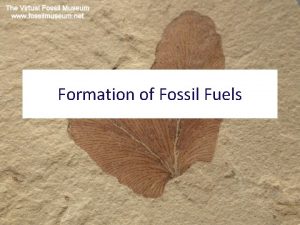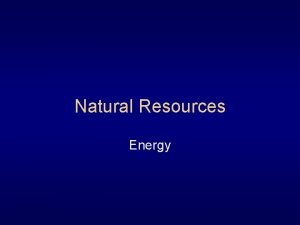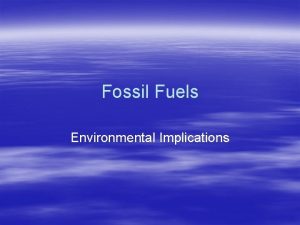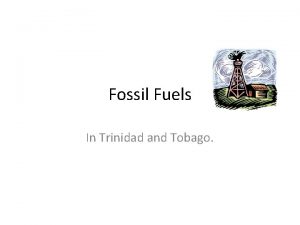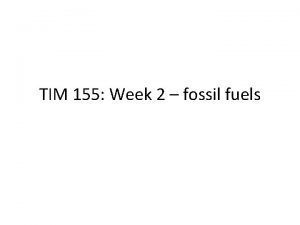FOSSIL FUELS I PETROLEUM Should the Keystone XL



























































- Slides: 59

FOSSIL FUELS I PETROLEUM

Should the Keystone XL pipeline be built? Yes 2. No 1.

Should ANWR be opened up to oil drilling Yes 2. No 1.

n Approximately 84% of the energy used in the US comes from fossil fuels ØOil and Natural Gas (Petroleum) ØCoal ØOil Shale and Tar Sand § Nonrenewable Resource (Fuel)

Formation Process Formation takes 10’s to 100’s of million years. 1. Dead plants and Animals accumulate on ancient sea floor. 2. Sandstone layer forms over source bed. 3. High Pressure and Temperature results in a loss of Oxygen in the compounds n

Results in various hydrocarbons (organic compounds with mostly Hydrogen and Carbon in them…more later). These can be solid liquid or gas. 5. Liquid and gas migrate through porous rock layer (sand stone) until they get caught in a trap or escape. 4.

Types of Oil Traps Fold Salt Dome

Faults

1 st Oil Well Titusville PA

La Brea Tar Pits

Typical Deposit n A few miles across n Approximately 1 mile down (sometimes more. VERY HARD TO FIND

Tools for Searching for Deposits n Gravitational/Magnetic Anomalies Easy to do over a wide area, but is a very coarse measurement. Good to pick out regions for further study n Geological Survey Look at the rocks and minerals in the region. Certain types are indicative of hydrocarbon deposits.

Seismic Survey Gives a detailed picture of the subsurface n Very expensive n Used over limited but promising areas. n

Example Seismic Image

n Eventually you must drill a wildcat well. (1 st well in a region. ) n Even with all of the research, only 1 out of 9 wildcat wells results in a commercially viable well. n Historically, it takes about 11 years for a new discovery to begin producing. n https: //www. youtube. com/watch? v=u. NATp 0 a. Ck. Qg

A Which of the following is not a typical oil trap? 1. 2. 3. 4. Fault Fold Fracture Salt Dome

US Oil & Gas Locations

Production Primary Recovery gets 15% of oil n Secondary Recovery (pumping water down the well) gets another 20%. n 65% is still down there. n

Enhanced Production Much more expensive n Works by reducing surface tension and viscosity of the oil n

Enhanced Production Methods n Pump in pressurized Carbon Dioxide to reduce viscosity n Pump in steam to reduce viscosity n Add detergent to reduce surface tension with surrounding rock (then flood with water.

Petroleum Production Methods n Primary 15% recovered 85% remaining n Secondary add’l 20% recovered 65% remaining n Enhanced add’l 10% recovered 55% remaining

n Oil shale is sedimentary rock such as shale or marl, containing kerogen n Kerogen is a waxy oil precursor not yet transformed into petroleum n The rock is mined, and synthetic oil is produced n Energy yield much lower than conventional oil

US Oil Shale Locations

n Oil sands are unconsolidated sandstone deposits, containing bitumen or heavy crude oil n Bitumen is a viscous or semi-solid form of petroleum n The sand is mined or recovered by steam injection n Refined by cracking or blending, then processed in conventional refinery

Oil Sand Locations

n Oil sand recovery process is more efficient than that of oil shale

How much oil is left in the ground after recovery? 1. 2. 3. 4. 10% 15% 20% 55%

What is in Oil Hydrocarbons, These are the Alkanes Cn. H 2 n+2 The proportion of hydrocarbons in the petroleum mixture is highly variable between different oil fields and ranges from as much as 97% by weight in the lighter oils to as little as 50% in the heavier oils and bitumens.

n Crude oil ~ 85% carbon n Oil has about 45 MJ/kg of energy

Generally we must treat oil from the ground n Fractional: Distillation: The vapors of different hydrocarbons condense at different temperatures .

Oil Refinery Refining Video

n n n Problem: Generally have too many heavy compounds and not enough light ones. Solution: Break apart long hydrocarbons into shorter pieces. Two techniques: 1. Cracking: uses high pressure and temperature 2. Catalytic conversion: pass petroleum over an Al-Si mixture:

Product Percent of Total Lubricants 0. 9 % Other Refined Products 1. 5 % Asphalt and Road Oil 1. 9 % Liquefied Refinery Gas 2. 8 % Residual Fuel Oil 3. 3 % Marketable Coke 5. 0 % Still Gas 5. 4 % Jet Fuel 12. 6 % Distillate Fuel Oil 15. 3 % Finished Motor Gasoline 51. 4 % One barrel contains 42 gallons of crude oil. The total volume of products made from crude oil based origins is 48. 43 gallons on average - 6. 43 gallons greater than the original 42 gallons of crude oil. This represents a "processing gain" due to the additional other petroleum products such as alkylates are added to the refining process to create the final products. Additionally, most gasoline contains approximately 10 percent by volume of ethanol, a non-petroleum-based additive that brings the total processing gain to 8. 59 gallons (or 50. 59 total gallons).

You can also form long hydrocarbon chains by combining light ones n Important forming material such as nylon, rayon and plastics. n

Fun Fact… The refining of oil is a very energy intensive process. Approximately 7. 5% of the total US energy consumption goes into running oil refineries.

Gasoline Octane Rating n Normal gasoline is composed of hydrocarbons with 5 -10 Carbon atoms n Each one burns differently n Octane: C 8 H 18 is a standard for comparison, it burns very smoothly. n Heptane: C 7 H 16 burns explosively, causes inefficiency and engine “knock”

n Octane rating n Pure Octane: n Pure Heptane: n 90% Oct, 10% Hep 100 0 90 We may use additives to produce a fuel with the same level of “engine knock” as a given Octane-Heptane mix. This is given the same octane rating (tetraethyl lead was the old additive… it is now illegal. )

n For diesel, the Cetane number is used n Cetane is C 16 H 34 n Cetane has the opposite effect of octane

Burning of Gasoline n Ideal n 2 C 8 H 18 + 25 O 2 16 CO 2 + 18 H 2 O + energy n Gas + Air Carbon Dioxide + Water + energy n More realistic n 2 C 8 H 18 + 25 O 2 14 CO 2 + 2 CO + O 2 + 18 H 2 O + energy.

n The CO 2 by burning fossil fuels is generally believed to be causing significant changers to the earth’s climate. In addition, nitrogen in the air combines to produce nitrous oxides (big part of smog) NOx N 2 +2 O 2 2 NO 2 N 2 +O 2 2 NO

Oil refining is an energy intensive process True 2. False 1.

Which of the following retards combustion? Heptane 2. Octane 3. Cetane 1.

WORLD & US OIL RESERVES 2003 n WORLD 1644 billion barrels n US 36 billion barrels (2. 2%) n Lifetime of US supply based on Rate equation: 10 yrs

Proven Reserves (2013)


Oil Producers and Consumers

US Oil Produced and Found

Net Difference Between Annual World Oil Reserves Additions and Annual Consumption.

Hubbert Analysis n 1956 Marion King Hubbert n Analysis for natural resources. n Applied to fossil fuels. n Rate of production tends to follow a bell-shaped curve.

Hubbert Analysis n Rate of production tends to follow a bell-shaped curve. – Early (pre-peak): rate increases due to discovery of reserves & building infrastructure. – Later (post-peak): rate decreases due to resource depletion.

Hubbert Analysis In 1956 Hubbert predicted US oil production would peak in late 60’ or early 70’s. n It peaked in 1970. n

Hubbert Analysis World

Hubbert Analysis World

Hubbert analysis can be applied to which of the following Only fossil fuels 2. Only nonrenewable resources 3. Only renewable resources 4. Any natural resource 1.

Projected Date of World Peak Production Source of Projection Background 2006 -2007 Bakhitari, A. M. S. Iranian Oil Executive 2007 -2009 Simmons, M. R. Investment Banker After 2007 Skrebowski, C. Petroleum journal Editor Before 2009 Deffeyes, K. S. Oil company geologist Before 2010 Goodstein, D. Vice Provost, Cal Tech Around 2010 Campbell, C. J. Oil company geologist After 2010 World Energy Council World Non-Government Org. 2010 -2020 La. Herrere, J. Oil company geologist 2016 EIA nominal case DOE analysis/information. After 2020 CERA Energy consultants 2025 or later Shell Major oil company No visible peak Lynch, M. C. Energy economist

What about ANWR

What about ANWR? The Alaska National Interest Lands Conservation Act (1980) established the Arctic National Wildlife Refuge (ANWR). In section 1002 of that act, Congress deferred a decision regarding future management of the 1. 5 -million-acre coastal plain in recognition of the area’s potentially enormous oil and gas resources and its importance as wildlife habitat. A report on the resources, including petroleum, of the 1002 area was submitted to Congress in 1987 by the Department of the Interior (DOI). Since completion of that report, numerous wells have been drilled and oil fields discovered near ANWR, new geologic and geophysical data have become available, seismic processing and interpretation capabilities have improved, and the economics of North Slope oil development have changed significantly.

What about ANWR? The government estimates up to 16 billion barrels of oil in ANWR are technically recoverable, although much of that would be too expensive to produce at today's prices. With prices were at or above $35 a barrel, energy companies could economically recover an estimated 6 billion barrels of oil from ANWR. Note: the US use about 7. 5 billion barrels of oil per year.

Should ANWR be opened up to oil drilling Yes 2. No 1.
 Advantage of fossil fuels
Advantage of fossil fuels Benefits of using fossil fuels
Benefits of using fossil fuels Advantages and disadvantages of fossil fuels
Advantages and disadvantages of fossil fuels Fossil fuels formula
Fossil fuels formula Is petroleum a fossil fuel
Is petroleum a fossil fuel Energy conversions examples
Energy conversions examples Fossil fuels summary
Fossil fuels summary Electricity pros and cons
Electricity pros and cons Fossil fuels
Fossil fuels Similarities between biofuels and fossil fuels
Similarities between biofuels and fossil fuels Fossil fuels summary
Fossil fuels summary Advantage of using fossil fuel
Advantage of using fossil fuel Advantage of natural gas
Advantage of natural gas Deposit
Deposit Fossil fuels include
Fossil fuels include Fuels
Fuels What are resources that can be replaced
What are resources that can be replaced What are fissil fuels
What are fissil fuels Classification of fuels
Classification of fuels Minerals and fuels
Minerals and fuels Renewable fuels association
Renewable fuels association Support nuclear energy
Support nuclear energy Minerals and fuels
Minerals and fuels Classification of natural resources
Classification of natural resources Keystone acidosis
Keystone acidosis Baby bones
Baby bones Keystone outline
Keystone outline Biology keystone review packet answer key
Biology keystone review packet answer key Biology keystone review packet answer key
Biology keystone review packet answer key How to write an a+ research paper keystone
How to write an a+ research paper keystone Keystone
Keystone Reeling gait
Reeling gait Keystone knowledge park
Keystone knowledge park Difference between african elephant and asian elephant
Difference between african elephant and asian elephant A keystone species is a species of plants and animals
A keystone species is a species of plants and animals The bridgeman art library/keystone
The bridgeman art library/keystone Catci
Catci Leader habit quiz
Leader habit quiz Keystone practice test algebra 1
Keystone practice test algebra 1 Clownfish niche
Clownfish niche Keystone
Keystone Are the keystone exams mandatory
Are the keystone exams mandatory Symbiosis and species interactions keystone webquest
Symbiosis and species interactions keystone webquest 5 levels of organisms
5 levels of organisms Biology keystone review packet
Biology keystone review packet 8500 keystone crossing
8500 keystone crossing Keystone innovation zone
Keystone innovation zone The book of mormon keystone of our religion
The book of mormon keystone of our religion Keystone released items
Keystone released items Keystone species quiz
Keystone species quiz Gimp keystone correction
Gimp keystone correction Lena andersson pench
Lena andersson pench Keystone technology consultants
Keystone technology consultants Keystone national highschool
Keystone national highschool A gap in the bridge cartoon analysis
A gap in the bridge cartoon analysis Keystone xl pipeline
Keystone xl pipeline Keystone clearwater solutions jobs
Keystone clearwater solutions jobs Taiga keystone species
Taiga keystone species Algebra
Algebra Keystone mutualist
Keystone mutualist
